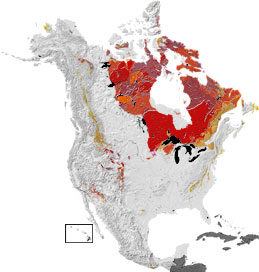the Precambrian - 4000 to 543 Million Years Ago
|
|
|
Paleontology and Paleoclimate: Earth was formed approximately 4.5 billion years ago (bya). For nearly 4 billion years after that, or roughly seven-eighths of the Earth's history, the only living things on Earth were single-celled organisms. This immense stretch of time is called the Precambrian, which can be divided into two eons: the Archean (approx. 4 bya to 2.5 bya) and the Proterozoic (2.5 bya to 543 million years ago). Some of the most important events in biological history took place during the Precambrian. Consider that the Earth formed, life originated, the first tectonic plates formed and began to move, eukaryotic cells evolved, the atmosphere became enriched in oxygen—and just before the end of the Precambrian, during a time interval called the Ediacaran (600-542 million years ago), complex multicellular organisms, including the first animals, evolved.
Paleogeography: Rodinia, the oldest supercontinent for which we have some record, formed during the middle Proterozoic (~ 1100 million years ago) with North America in the center, South America to the east, and Australia and Antarctica to the west. When the Panthalassic Ocean formed about 750 million years ago, Rodinia was split into two parts. One part (North America) moved south, crossing the pole, while the other (Antarctica, Australia, India, Arabia, and parts of China) headed toward the North Pole. By the end of the Precambrian (~ 600 million years ago), these two parts collided with the newly formed Congo craton (north-central Africa) and formed the supercontinent Pannotia.
|
|
 |
 |
 |
 |
|
North America Today

Most of what we know as present-day North America was underwater during the Precambrian. Later, limestones, sandstones, and shales were deposited on top of the Precambrian deposits, as North America was periodically covered by shallow seas or received sediments from higher ground. Several continental collisions pushed Precambrian basement rocks up, exposing them in mountainous regions like the Rockies and the Appalachians, as well as in northwestern Mexico and the Canadian Shield (throughout Wisconsin, Minnesota, Michigan, New York, and East Central Canada). However, Precambrian rocks underlie the majority of North America today.Zoom map
|
|
 |
 |
|
 |
See the Precambrian in:
Or jump to another period:
|
|
Links to more about the Precambrian
|
Organizations | Education and Exhibits | Research and Collections | Resources
Organizations
Museums (showing 2 of 2 listings)
University of Alaska Museum of the North--Arctic Dinosaurs and More: This is the principal natural history museum of Alaska and the Arctic. It features collections & exhibits of Arctic dinosaurs, Quaternary mammals, including unequaled mummified remains,Teriary and Mesozoic collections of mollusks. 
Garvies Point Museum official website: Garvies Point Museum and Preserve is located on Long Island's north shore in New York State. We are a center for regional geology research. Our exhibits deal with regional (Long Island and New York State) geology, fossilization and minerology and the ehnography and archaeology of northeastern Native Americans. Our exhibit "Drifitng Lands and Ancient Seas" details the geology of New York State coordinated with plate tectonics. 
 Top of List Top of List
Education and Exhibits
Virtual Exhibits (showing 3 of 5 listings)
Virtual Museum of Fossils: Geosciences, at Georgia's Valdosta State University, presents an interactive virtual museum of invertebrate and vertebrate fossil specimens. Explore the collection by animal, or by time period from Precambrian to Quaternary. Maps are detailed and include ecosystem distribution. Fossil photographs, many showing multiple views, list information about where the fossil was found, and how it is categorized taxonomically. Some pages feature a drawing of the animal's skeleton showing the fossil bone in red.
The Third Planet - a walk through geologic time: This virtual exhibit offers a tour of the Milwaukee Public Museum's geology exhibits, depicting the continuing evolution of the Earth from the Precambrian to present.
First Families of Chicago: Local geology of the Chicago, Illinois, area, complete with descriptions of the fossils found there.
 More Virtual Exhibits More Virtual Exhibits
 Top of List Top of List
Research and Collections
Ongoing Research Projects (showing 1 of 1 listings)
Big Sioux River: Descriptions, photos and maps showing the Big Sioux River geology, origin, flora and fauna, with emphasis on Sioux Quartzite formations.
 Top of List Top of List
Researchers (showing 1 of 1 listings)
University of Kansas Paleobotanical Collection: Collection of fossil plants currently housed at the University of Kansas.
 Top of List Top of List
Resources
Courses and Lectures (showing 1 of 1 listings)
Paleogeography of the Southwestern U.S.: The paleogeography of the southwestern U.S. from 1.8 billion years ago to 10 million years ago. Text and images by Dr. Ron Blakey from Northern Arizona University.
 Top of List Top of List
Annotated Bibliographies (showing 1 of 1 listings)
Bibliography of Paleobotany: A bibliographic database of paleobotany including more than 56,000 entries. It also includes references on Antarctic geology and paleontology and citations on Women in Science.
 Top of List Top of List
Maps (showing 1 of 1 listings)
Paleogeography and Geologic Evolution of North America: The images presented here show the paleogeography of North America over the last 550 million years of geologic history.
 Top of List Top of List
Databases (showing 1 of 1 listings)
Stratigraphy.net: Stratigraphy.Net aims to provide free and open access to geoscientific information and data with special emphasis on the disciplines stratigraphy, paleontology and sedimentology.
 Top of List Top of List
Image Collections (showing 1 of 1 listings)
Michigan Basin Specimen Database: This site showcases Michigan Basin fossils from the private collections of Friends of the University of Michigan Museum of Paleontology and select specimens from the University of Michigan collection, including type specimens.
 Top of List Top of List
General Reference (showing 2 of 2 listings)
Precambrian Stromatolites of Sonora, Mexico: A discussion of Sonoran stromatolite fossils accompanied by photographs.
List of Dinosaurs: This dinosaur listing is data-packed and can be sorted by dinosaur length, weight, time period, etc.
 Top of List Top of List
|
|



